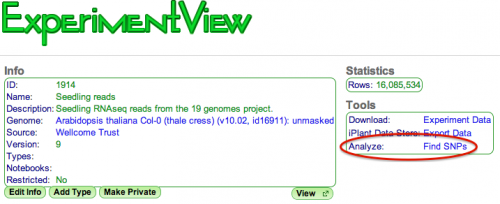Identifying SNPs: Difference between revisions
Jump to navigation
Jump to search
No edit summary |
No edit summary |
||
| Line 4: | Line 4: | ||
An alignment-type experiment in CoGe is created by loading a BAM file. See [[LoadExperiment]] for instruction on how to do this. | An alignment-type experiment in CoGe is created by loading a BAM file. See [[LoadExperiment]] for instruction on how to do this. | ||
The CoGe SNP finding pipeline detects SNPs that meet the following criteria: | |||
* minimum read depth of 10 | |||
* minimum high-quality allele count of 4 (high quality is PHRED >= 20) | |||
* minimum allele frequency of 10%. | |||
We are working to incorporate other SNP-finding programs into CoGe. | |||
Revision as of 19:12, 16 May 2014
CoGe has a built-in SNP finding pipeline! To find SNPs in an existing alignment-type experiment, select the "Find SNPs" analysis tool in the ExperimentView page.

An alignment-type experiment in CoGe is created by loading a BAM file. See LoadExperiment for instruction on how to do this.
The CoGe SNP finding pipeline detects SNPs that meet the following criteria:
- minimum read depth of 10
- minimum high-quality allele count of 4 (high quality is PHRED >= 20)
- minimum allele frequency of 10%.
We are working to incorporate other SNP-finding programs into CoGe.